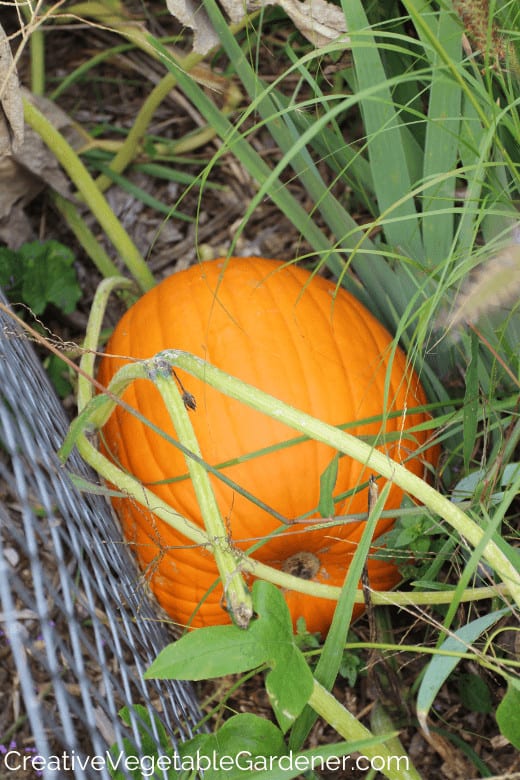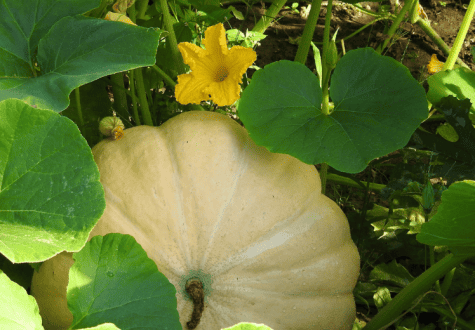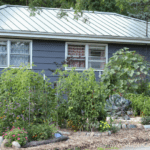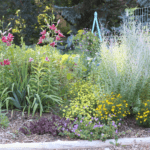
Pumpkins bring out the child in all of us. We love seeing the colorful Jack O’ Lanterns at Halloween, and it’s exciting to see pumpkins ripening in the fields, their bright orange colors blending into the autumnal landscape.
Did you ever consider growing your own pumpkins? Pumpkins are a fun addition to any garden, and while they require a little space, they’re not hard to grow.
Pumpkins do require full sun, and the larger varieties require space because their vines can grow 20 feet long. However, if you’re space-challenged, there are smaller varieties available, and there are also some space-saving tips we’ll discuss later.
Before you begin planning your garden, you might want to read more about growing pumpkins in raised beds.
You’ll also want to learn more about the pumpkin growing stages, how many pumpkins you can expect from each plant, what the plants look like and how long they take to grow. In this article, we’ll dive into those topics and get you on the (garden) path towards growing pumpkins successfully.
What Are the Pumpkin Growing Stages?
First, let’s get more familiar with the life of a pumpkin plant by taking a look at the pumpkin growing stages.
The first stage is planting a seed in the soil of your garden.
After that comes seed germination, which generally occurs within a week to 10 days if the soil is warm. This is when the first leaves pop through the soil and you jump for joy because there’s something green growing!
Now that the first leaves have popped the tiny seedling can start working on producing true leaves, usually within a week.
Once the true leaves start growing, the plant’s ready for the final five pumping growing stages.
These include the following:
Growth of the vine. This occurs very quickly, and the vines can get visibly longer each day in sunny weather.
The next pumpkin growing stage is blooming. The attractive bright yellow blooms usually start to appear 8-10 weeks after planting. The male blooms appear first, followed by the females 10 days later.
At this stage, make sure the plant is receiving at least one inch of water per week. Read these secrets to watering your vegetable garden the right way.
The next step is pollination, when bees transfer pollen from the male flower to the female.
When the female blossoms are pollinated, they will soon begin to produce fruit, which will continue to grow for up to 55 days. The immature fruit will be deep green, and it will gradually change colors as the fruit ripens.
The final stage is harvesting. When the pumpkin is ready for picking, the vines will wither and die, and the fruit will have a hollow noise if you thump on it.

How Many Pumpkins Per Plant?
Before you begin planting your pumpkin patch, you’ll probably want to know how many pumpkins you can expect from each plant so you can decide how many you’d like to grow.
That depends on the size of the plant. Large carving pumpkins such as the Howden, usually only produce a couple of pumpkins per vine. Some, such as the smaller Autumn Gold, can produce up to 10 fruits per plant. Very small pumpkins, such as the Jack Be. Little, can produce up to 12 pumpkins.
It’s important to research the varieties of pumpkins before you select your seeds. Carving pumpkins, which are used to make Jack O’ Lanterns, are often larger than pie pumpkins, which are used in baking.

What Do Pumpkin Plants Look Like?
Pumpkin plants are very easy to identify in the garden. First, while there are some small varieties, a large pumpkin plant can produce vines that extend for 20 feet.
Remember that if space is a challenge, it’s possible to grow small varieties, such as Baby Boo, on an overhead trellis. I grow most of my winter squash and pumpkins on my cattle panel trellises.
The leaves are quite large and deep green with a smooth texture and pointed lobes. The plant also produces very attractive yellow or orange flowers that attract pollinators.
Of course, it’s easy to identify the plant once it starts to produce fruit because the fruit is large, generally round or oblong, and usually orange as the fruit matures. However, not all varieties of pumpkins are orange, and many gardeners are now opting for the ghostly white pumpkins or the bright reds or pastels of the Cinderella or Porcelain Princess pumpkins.

How Long Does It Take To Grow Pumpkins?
Pumpkins take 90-120 days to mature after they’re planted, depending on the weather and variety. Some small varieties, such as the Jack Be Little, might mature in 85 days, while the larger Musquee De Provence can take 125 days.
Generally, pumpkin seeds will germinate within 10 days of planting. Within a week true leaves will appear and the vines will start to grow. Expect blooming within 8 to 10 weeks, and soon afterward fruits will start to appear.
The pumpkins will grow rapidly, and it generally takes 40-50 days from the time the fruit appears until it’s ready for harvest.

When Do Pumpkins Grow?
Pumpkins, which are related to squash and gourds, are like winter squash in that they grow during warm weather and ripen in the fall.
Wait to plant until the soil and air are completely warm. Where I live in zone 5a Wisconsin, I usually plant pumpkins in mid to late May after all danger of frost has passed. Beware, pumpkin plants are not frost tolerant, so don’t plant them too early in the season.
Of course, planting when the weather is warmer means you should mulch and water well until the plants become established. Be careful not to overwater squash plants because they don’t like to be wet all of the time and are susceptible to fungal issues.
If you live in a very cold climate, or you just want to get an early start on the season, you can sow the seeds indoors and transplant them outside after the weather has warmed. Plant in a seed starting tray and make sure that the seeds stay warm and receives plenty of light. If you’re starting lots of seeds, you’ll need grow lights for seed starting.
The vines and fruit will continue to grow throughout the summer season. Towards the end of summer, the fruit will begin to ripen and eventually and the vines will begin to die in very late summer or early fall. This is a sign that the fruit is ripe, but before you pick it thump it with your forefinger first to make sure. If it makes a hollow sound, it’s ripe for the picking.
Watering, Harvesting and Storing
If you’re intrigued about growing pumpkins this season, I wrote another article about watering pumpkins that also covers when and how to harvest, and how to store them.
Let’s Get Started!
Now you know more about the pumpkin growing stages. Remember that it’s important to select the variety that’s right for you. Consider what you plan to do with the pumpkin. If you’re aiming for a large carving pumpkin for Halloween, choose the thinner-skinned carving pumpkins such as the Captain Jack Pumpkin or the Musquee De Provence.
If you’re craving the warm, savory smells of homemade pumpkin pie, choose pie pumpkins such as the Sugar Pie Pumpkins, which have denser flesh than the ornamental varieties.
With a little planning, pumpkins can make a wonderful addition to your home vegetable garden, so consider adding them to your planting list for this season!
Read my other articles about growing pumpkins to become a real pro!
- Watering Pumpkins: Best Practices for Growing Great Pumpkins
- Seed to Harvest: Growing Pumpkins in Raised Beds
SHARE IT ON PINTEREST









